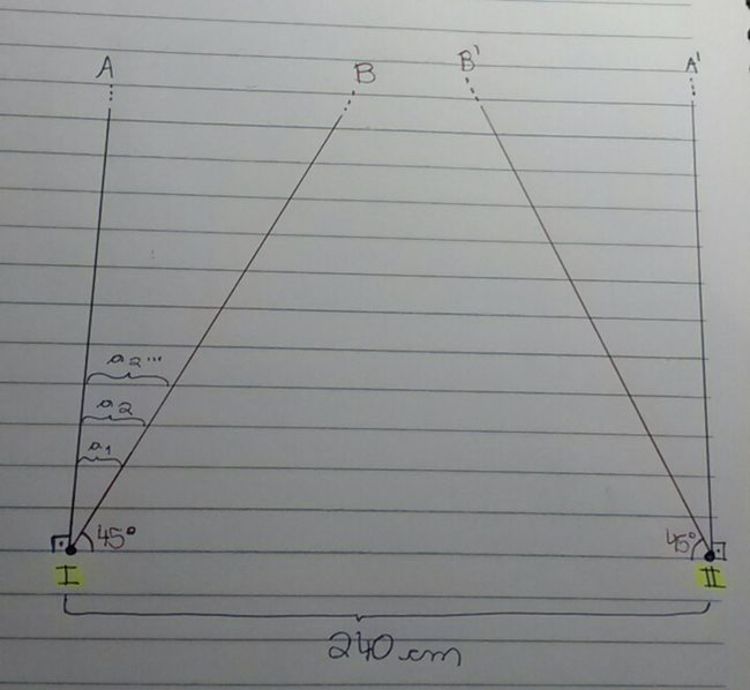Dot Expansion
 There are two equal dots, I and II. Both dots are in the same horizontal line, called C, at a distance of 240cm from each other. The dot I expands itself, creating an infinite line, called A, which makes 90 degrees with C. The dot II does the same, but the line created is called A'. The dot I also expands itself to the right, creating another line, called B, that makes a 45 degrees angle with C. At the same time, the dot II starts to expand itself to the left, creating a line, called B', that also makes a 45 degrees angle with C. Dot I expands the line B by 1,2cm each second, and so does dot II to the line B' (their speed on the lines B and B' is
) . Let
be the time, in seconds, that it takes to both dots meet in their expansions on the lines B and B'. Also, let
be the distance, in centimeters, that the dot II runs on the line B' until it meets the dot I on the line B. Consider
. What is the value of
?
There are two equal dots, I and II. Both dots are in the same horizontal line, called C, at a distance of 240cm from each other. The dot I expands itself, creating an infinite line, called A, which makes 90 degrees with C. The dot II does the same, but the line created is called A'. The dot I also expands itself to the right, creating another line, called B, that makes a 45 degrees angle with C. At the same time, the dot II starts to expand itself to the left, creating a line, called B', that also makes a 45 degrees angle with C. Dot I expands the line B by 1,2cm each second, and so does dot II to the line B' (their speed on the lines B and B' is
) . Let
be the time, in seconds, that it takes to both dots meet in their expansions on the lines B and B'. Also, let
be the distance, in centimeters, that the dot II runs on the line B' until it meets the dot I on the line B. Consider
. What is the value of
?
Notes and Assumptions :
Use a protractor on a notebook page to create the lines B and B'. Try to do just as the image. Do not use trigonometric measures for the given angles (for real). Also, consider that the initial positions, vertical and horizontal, of both dots is 0 centimeters.
The answer is 330.
This section requires Javascript.
You are seeing this because something didn't load right. We suggest you, (a) try
refreshing the page, (b) enabling javascript if it is disabled on your browser and,
finally, (c)
loading the
non-javascript version of this page
. We're sorry about the hassle.
Let's use the lines of a notebook as a reference. If you draw, just as the image, the lines B and B' (making a 45 degrees with the line C), you will notice that the distance between the line A and the line B, just as the distance between the line A' and B', is an arithmetical progression with common difference equal to 0,8cm. If the dots started to expand themselves at the same time, and they have the same speed on the lines B and B', so they will meet after both run a distance of 120cm, which is half of the distance between the dots.
So, to find α, we have to find what is the position of the term 120 of the arithmetical progresson that represents the distance between the lines A and B, and A' and B', because this distance is equal to the horizontal distance that each dot run per second. The position of 120 in the arithmerical progression is 151. It means that it takes the dots 150 seconds to run horizontal 120 centimeters. So α = 150s.
As the initial position of the dot II is 0, we can say that S = v.t, where S is the final position, v is the dot's speed on the line B' and t is the time that will have passed when the dot reaches the position S. So, the speed is 1,2cm/s and the time it takes the dot II to reach the horizontal position where it meets the dot I, which is on the line B, is α, that is equal to 150 seconds. Then, S = 1,2 x 150 => S = 180cm, which is the distance that the dot II will have run on the line B' when t = 150s. So, β = 180. Hence, ε = 150 + 180 . Then ε = 330, and the floor function of ε is 330 .